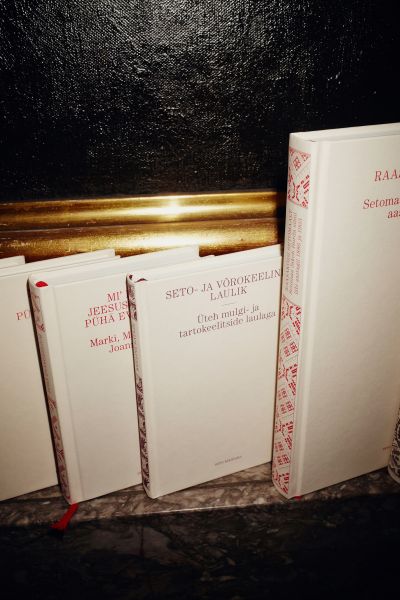The Seto Library. Seto Kirävara
- Kategorie
- Honorary Appreciation
Begründung der Jury
★
Estonia /// Estland
★
This book series is published by the Seto Institute, which is dedicated to the cultivation and documentation of a language in the south east of Estonia: Seto. These days it is only spoken by a few thousand people. This publishing commitment considers a full library of Seto books. Poetry, songs, biographies, the gospels, folklore are preserved in printed form. Depending on the text type, two formats are available. The design of this book series does not refer so much on textual contents but rather on the cultural similarities of this small linguistic group. The humble paperbacks hint at the characteristics of national costumes. White linen here, fragmented paper white there—embroidery and borders here—or geometric textile ornaments on the spines. The cover is printed in a single colour, from volume to volume in changing red hues; headband and bookmark are chosen in matching colours. The robust style of the edges, which slightly protrude over the book block, embraces the rustic traditions of the Setukese people. This series clearly shows once again that, as hardly any other tool, the book as a medium serves the identity formation of a society and the preservation of immaterial heritage.
★
Die Büchergruppe wird vom Seto-Institut herausgegeben, das sich der Pflege und Dokumentation einer Sprache im Südosten Estlands, dem Setu, widmet. Es wird nur noch von einigen Tausend Menschen gesprochen. Mit diesem publizistischen Engagement ist an eine regelrechte Bibliothek des Seto gedacht. Dichtung, Lieder, Biografisches, die Evangelien, Volkskundliches werden in Buchform konserviert. Zwei Formate stehen je nach Textsorte zur Verfügung. Der buchgestalterische Reihencharakter bezieht sich weniger auf einen inhaltlichen Zusammenhang als vielmehr auf die kulturellen Gemeinsamkeiten dieser kleinen Sprachgruppe überhaupt. Die schlichten Pappbände zitieren Merkmale von Trachten. Dort weißes Leinen, hier gebrochenes Papierweiß – dort Stickereien und Bordüren – hier geometrische, textile Ornamente auf den Buchrücken. Der Einbandbezug wird einfarbig bedruckt, von Band zu Band in wechselnden Rottönen; Kapital- und Zeichenband sind jeweils farblich passend dazu gewählt. Die robuste Machart der etwas weit über den Buchblock ragenden Stehkanten ist der ländlichen Tradition der Setukesen angemessen. An dieser Reihe wird einmal mehr deutlich, dass das Buch als Medium wie kaum ein anderes der Identitätsbildung von Gemeinschaft dient, als Medium, immatrielles Kulturerbe zu bewahren.

